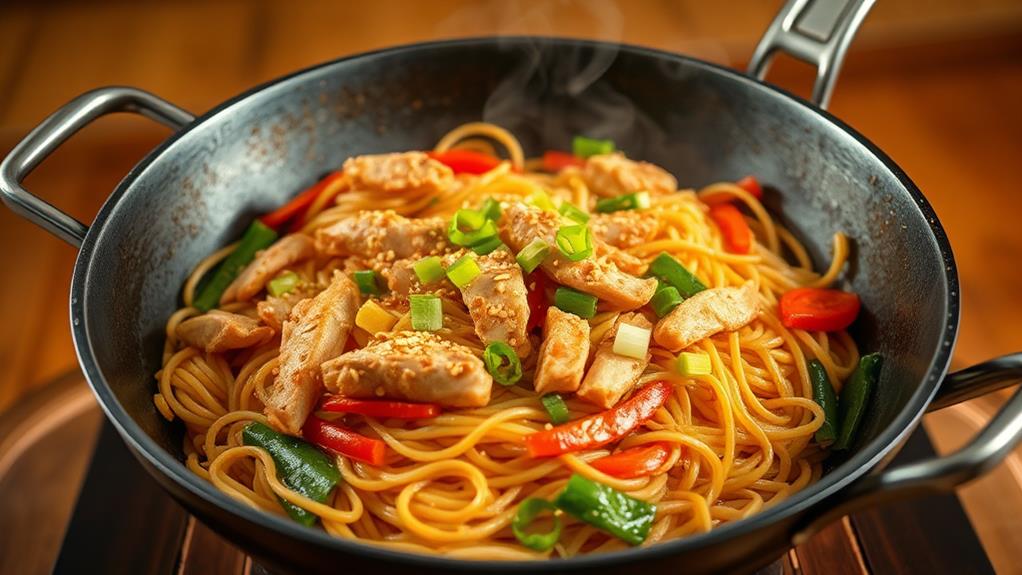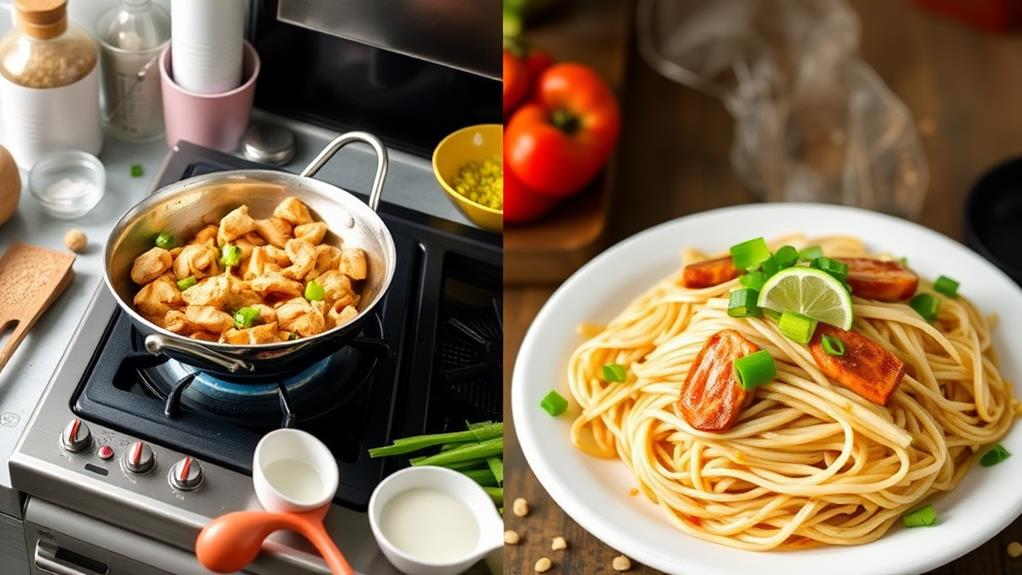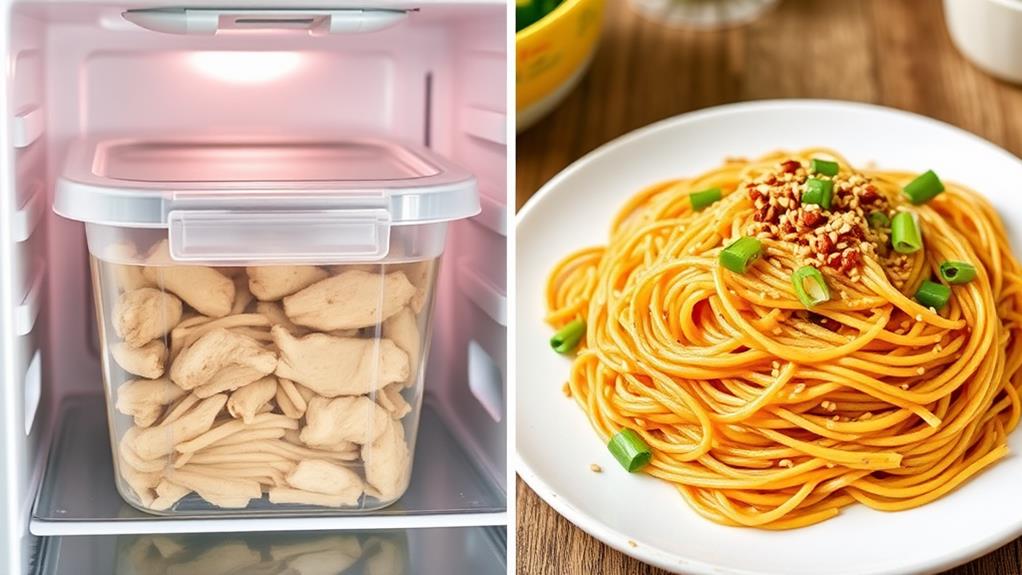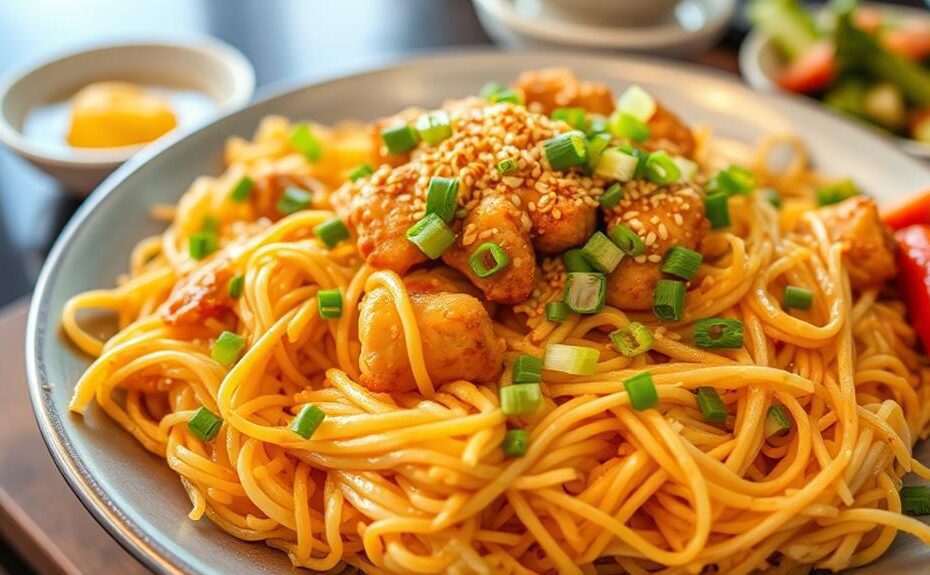Step 1: Prepare the Noodles
Soak 1 lb of bihon noodles in warm water for 30 minutes to rehydrate them.
Step 2: Sauté Onions and Garlic
Heat a wok over medium-high heat and sauté onions and garlic to build flavor depth.
Step 3: Cook the Chicken
Add thinly sliced chicken breast to the wok and cook until browned and juicy.
Step 4: Add Mixed Vegetables
Add mixed vegetables to the wok and cook until they are tender yet crisp.
Step 5: Combine Noodles and Sauce
Combine the soaked noodles with the sauce and stir-fry until heated through.
Tips for Experimentation
Don't be afraid to experiment with variations of Pancit Bihon Flavor by adding different vegetables, proteins, or spices to create your own unique recipe.
Traditional Pancit Bihon Recipe

Preparing the Noodles
To start, prepare the bihon rice noodles, which form the foundation of a traditional Pancit Bihon Recipe. These thin rice vermicelli noodles are ideal for absorbing flavors, making them the perfect base for this Filipino dish.
Adding Aromatics
Next, sauté a variety of aromatics, including onions and garlic, to add depth to your pancit. This step brings out the flavors of the dish.
Adding Protein and Vegetables
Add your chosen protein, chicken, and cook until it's fully incorporated.
Then, add assorted vegetables like carrots, cabbage, and bell peppers, which add crunch and color to your dish.
Stir-Frying and Seasoning
To bring everything together, stir-fry your ingredients in a savory mixture of soy sauce and sometimes chicken bouillon or oyster sauce, depending on your personal preference.
This harmonious blend of ingredients results in a pancit bihon that's both flavorful and authentic.
Easy Chicken Pancit Ingredients
Easy Chicken Pancit Ingredients: A Balanced Combination
The Easy Chicken Pancit recipe relies on five essential components: protein, vegetables, aromatics, noodles, and seasonings. These components work together to create a harmonious balance of flavors and textures in this traditional Filipino dish.
Protein: Adding Flavor and Variety
Protein is a crucial component that adds flavor and variety to the dish. Examples of protein sources include chicken breast, shrimp, and pork, which are typically thinly sliced to enhance flavor absorption.
Vegetables: Providing Texture and Nutrients
Vegetables provide a mix of textures and nutrients to the dish. Common vegetables used in Chicken Pancit include carrots, cabbage, and bell peppers, which add crunch, flavor, and nutrients.
Aromatics: The Flavor Base
Aromatics form the flavor base of the dish, releasing fragrances when sautéed. Garlic and onion are essential aromatics that add depth and complexity to the sauce.
Noodles: Absorbing Flavors
The noodles used in Chicken Pancit are thin rice vermicelli called bihon noodles, which absorb flavors well during cooking.
Seasonings: Enhancing Flavor
Soy sauce, oyster sauce, and chicken bouillon powder are essential seasonings that enhance the dish's savory profile. These seasonings combine to create a savory sauce that complements the bihon noodles and other ingredients.
Step-by-Step Cooking Instructions

Cook the Noodles
Soak 1 lb of bihon rice noodles in warm water for about 30 minutes until they're softened and pliable for cooking.
Sauté the Aromatics
Heat a wok over medium-high heat. Add 1 diced onion and ½ tbsp of minced garlic in oil until fragrant. This forms the flavor base for the dish.
Cook the Chicken
Add ½ lb of thinly sliced chicken breast to the wok and cook until browned and fully cooked through. Ensure the protein is juicy.
Add Vegetables
Incorporate 1 cup of mixed vegetables, such as carrots and cabbage, and sauté briefly until they're tender yet still crisp. This enhances the dish's texture.
Combine and Serve
Mix in the soaked noodles with a soy sauce-based sauce, stir-frying everything together until the noodles are evenly coated and heated through.
The easy Filipino dish recipe is now ready to be served, with the rice vermicelli noodles perfectly cooked and the flavors well-balanced.
Expert Tips and Variations
Elevate Your Chicken Pancit Bihon with Expert Tips and Variations
Marinate for Deeper Flavors
Marinate your chicken in soy sauce, garlic, and pepper for at least 30 minutes to infuse deeper flavors into your dish. This step allows the chicken to absorb the flavors, making it more savory and aromatic.
Mix in Vegetables for Texture and Nutrition
Add a variety of vegetables such as snow peas, bell peppers, and green onions to enhance the texture and nutritional value of your pancit. This won't only add crunch and color but also provide essential vitamins and minerals.
Experiment with Protein Options
Try substituting chicken with other protein options like shrimp or tofu to cater to different dietary preferences. This variation allows you to accommodate guests with specific requirements, making your dish more inclusive.
Umami Flavor Profile
Add a splash of oyster sauce to elevate the umami flavor profile, making your pancit more savory and rich. This will balance out the flavors and create a harmonious taste experience.
Spicy Kick
Include chili flakes or sliced fresh chili peppers when sautéing the vegetables if you prefer a spicier kick. This will add a bold and spicy flavor to your dish, perfect for those who enjoy a little heat.
Can I Add Different Flavors to Chicken Pancit Bihon to Make It Unique?
Yes, you can add various flavors to your delicious chicken pancit bihon recipe to make it unique. Try mixing in some soy sauce, sesame oil, and ginger for an Asian twist. Or, add some curry powder and coconut milk for a more exotic flavor profile. The options are endless!
Storage and Reheating Guidance

Proper Storage Ensures Freshness and Safety
To keep Chicken Pancit Bihon fresh, safe, and flavorful, store leftovers in an airtight container in the refrigerator for up to 3-4 days.
For longer storage, freeze it in a sealed bag or container for up to 3 months, preserving its flavor and texture.
Reheating Guidelines for Optimal Results
To reheat Chicken Pancit Bihon correctly, follow these steps:
Reheat in a microwave covered with a lid or damp towel, heating in 1-2 minute intervals until warmed through.
Alternatively, reheat on the stovetop over low heat, stirring frequently to maintain moisture and even temperature throughout the dish.
If frozen, always allow it to thaw in the refrigerator overnight before reheating for best results.
Frequently Asked Questions
What Is the English Name for Bihon?
Rice Vermicelli is the English name for "bihon".
"Bihon" is a Filipino term that refers to a type of noodle made from rice flour and water.
This gluten-free ingredient is a staple in many bihon recipes, characterized by its slippery texture and ability to absorb flavors.
What Is the Difference Between Pancit and Bihon?
Pancit is a broad category of Filipino noodle dishes, encompassing various regional variations, cooking techniques, and flavor profiles. This means that Pancit can be made with different types of noodles, seasonings, and ingredients, depending on the region or personal preference.
Bihon, on the other hand, specifically refers to thin rice vermicelli noodles. These noodles are made from rice flour and are characterized by their thin, translucent, and delicate texture. In Filipino culture, Bihon noodles are often associated with good fortune and longevity.
The difference in noodle type between Pancit and Bihon affects the dish's texture, ingredient substitutions, and overall cultural significance. For example, Bihon noodles are often used in dishes where a light, delicate texture is desired, while thicker noodles may be used in heartier Pancit recipes.
Additionally, the cultural significance of Bihon noodles is tied to their association with good fortune and longevity, making them a popular choice for special occasions.
What Is Pancit Sauce Made Of?
Pancit sauce typically consists of a combination of soy sauce and chicken broth. The soy sauce provides a rich umami flavor, while the chicken broth adds depth to the sauce.
Garlic flavor is often infused throughout, along with traditional spices like black pepper. Some recipes may also include additional ingredients, such as calamansi or lemon juice for a sour kick or vegetable options for added flavor.
To enhance the flavor, sugar and sesame oil may be added.
How to Cook Super Q Bihon?
Soaking the Noodles
To begin cooking Super Q Bihon, soak the bihon noodles in warm water until they're softened. This step helps to rehydrate the noodles and makes them easier to cook.
Preparing the Skillet
Next, heat oil in a large skillet or wok over medium-high heat. Once the oil is hot, sauté minced garlic and onion until fragrant, which will add flavor to the dish.
Adding Protein and Vegetables
Add your chosen protein, such as chicken, beef, or tofu, and cook until browned.
Then, add a mix of colorful vegetables, such as bell peppers, carrots, and green beans, and cook until they're tender-crisp.
Combining the Sauce
In a separate bowl, mix together a savory sauce consisting of soy sauce, oyster sauce, and chicken broth.
Pour the sauce into the skillet and stir to combine.
Cooking the Noodles
Add the softened bihon noodles to the skillet and stir to coat them evenly with the sauce.
Cook for an additional 2-3 minutes, or until the noodles are heated through.
Serving
Serve the Super Q Bihon hot, garnished with your preferred toppings, such as lemon or calamansi for added zest.
